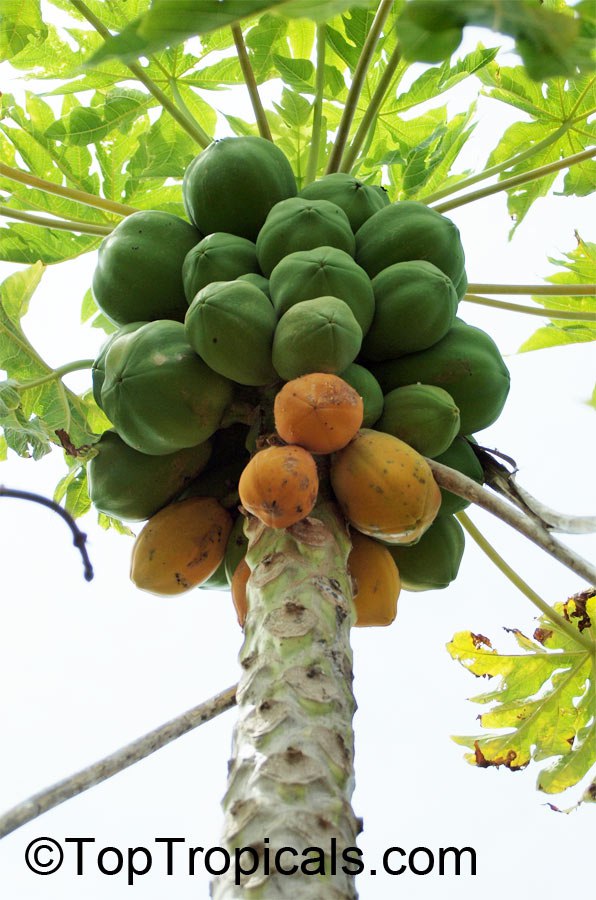Garden Blog - Top Tropicals
Carefree Garden: How Easy Is It to Grow a Papaya Tree?
Carefree Garden: How Easy Is It to Grow a Papaya Tree?
👆 For the previous post:
🎮 Practical Guide to Growing Papaya
📚More from previous posts:
Top 10 fruit you'll ever need for your health benefits: #4 Papaya
Top 10 fast-fruiting trees: #6. Papaya
How to have fresh Papaya fruit year around
Top 3 most wanted Papaya varieties
The truth about Papaya
Papayas contain a secret enzyme
🛒 Shop Papaya trees
#Food_Forest #How_to #Papaya
🔴 Join 👉 TopTropicals
👆 For the previous post:
🎮 Practical Guide to Growing Papaya
❤️ Papaya is one of the fastest fruiting plants to grow.
❤️ How Easy Are Papaya Trees to Grow?
❤️ What Light Levels and Soil Types Are Ideal?
❤️ How Much Watering Is Required?
❤️ Growing Papayas in Containers
❤️ Health Benefits of Papaya
❤️ Papayas are a low-maintenance, high-reward addition to a Southern garden or greenhouse collection, whether in the ground or in a container. Their fast growth, year-round fruiting potential, and health benefits make them a must-have for gardeners and fruit enthusiasts alike.
Often starting production the same year from planting a seed, papayas are ideal for gardeners seeking quick rewards. Many dwarf varieties reach only 6-8 feet tall, yet produce large crops of full-sized fruit that are easy to harvest. Papaya trees are space-efficient, making it possible to plant multiple trees in even small gardens. Plant 2-3 different cultivars to enjoy year-round harvests of healthy, delicious fruit.
Papaya trees are exceptionally easy to grow. Technically a large herbaceous plant rather than a true tree, they are resilient and adaptable. They can tolerate light freezes and even hurricane winds without significant damage. Additionally, many varieties are self-fertile, but planting multiple trees encourages better pollination and higher yields.
Papayas thrive in full sunlight, so choose a sunny spot in your garden or balcony. They prefer well-draining, fertile soil enriched with organic matter. Add compost or manure to improve soil quality and ensure healthy growth. Avoid waterlogged areas as papayas are sensitive to standing water.
Papayas need consistent watering to thrive, especially during the growing and fruiting seasons. Water deeply once or twice a week, depending on your climate, ensuring the soil remains moist but not waterlogged. Mulching around the base helps retain moisture and regulate soil temperature.
Papayas can be successfully grown in large containers, making them ideal for gardeners in cooler regions or those with limited space. Choose a container at least 15 gallons in size with good drainage. Use a rich, well-draining potting mix, and place the container in a sunny location. Select dwarf varieties to keep the plant manageable and productive.
Papaya is considered a superfood due to its high nutritional value. Rich in the enzyme papain, it aids digestion and promotes gut health. Papaya is also an excellent source of vitamins A, C, and E, as well as antioxidants that boost immunity and overall wellness. Additionally, papaya leaves can be used as wraps for cooking meats, naturally tenderizing them.
📚More from previous posts:
Top 10 fruit you'll ever need for your health benefits: #4 Papaya
Top 10 fast-fruiting trees: #6. Papaya
How to have fresh Papaya fruit year around
Top 3 most wanted Papaya varieties
The truth about Papaya
Papayas contain a secret enzyme
🛒 Shop Papaya trees
#Food_Forest #How_to #Papaya
🔴 Join 👉 TopTropicals
How to grow your own vanilla orchid at home

Vanilla Bean Orchid (Vanilla planifolia)
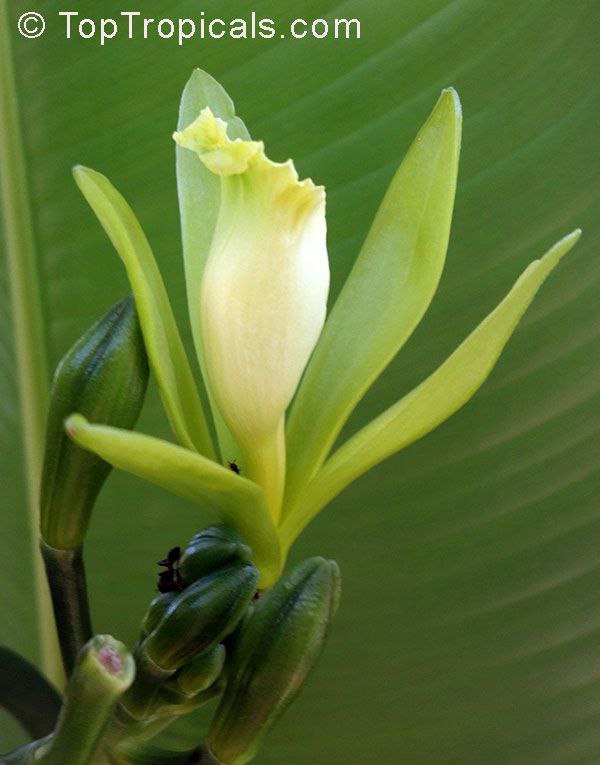
Vanilla Bean Orchid (Vanilla planifolia), flower
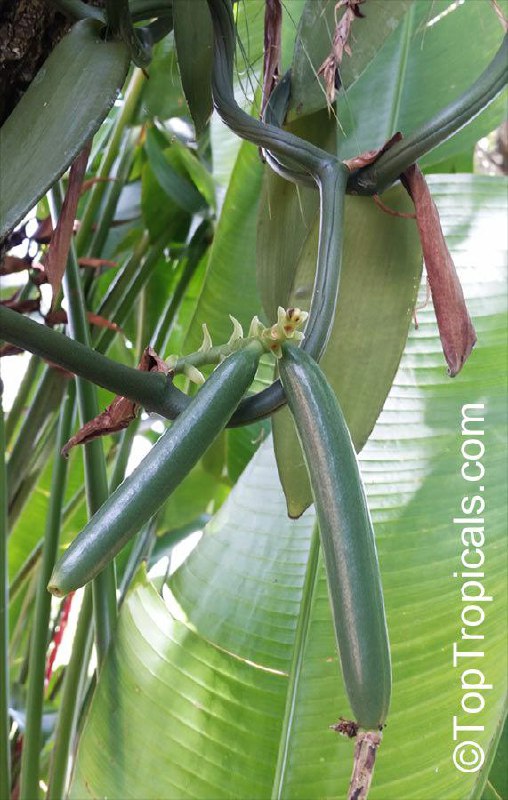
Vanilla Bean Orchid (Vanilla planifolia), seed pods beans

Vanilla Bean Orchid (Vanilla planifolia)
How to grow your own vanilla orchid at home
📚 Learn more from previous post:
The Secret of how to Make Vanilla Orchid bloom
🛒 Shop Vanilla Bean Orchids
#Shade_Garden #How_to
🔴 Join 👉 TopTropicals
- 🍨 The Vanilla Bean Orchid (Vanilla planifolia) is a tropical climbing beauty and the source of the world’s favorite spice - vanilla. This luxurious plant adds elegance to any space, indoors or out.
- 🍨 A piece of history: Once revered by the Aztecs for flavoring the decadent cacao drink Xoco-latl, vanilla remains a symbol of comfort, luxury, and flavor.
- 🍨 Why it's special: Vanilla pods are scentless at first and develop their rich aroma after careful curing - a reason it’s the second most expensive spice after saffron.
- 🍨 How to grow Vanilla Orchid:
- · Support: Use a trellis, log, or burlap-covered board for climbing.
- · Light: Bright, indirect light works best.
- · Environment: Keep it warm and humid, like its natural tropical habitat.
- · For pots: Add a mini-trellis or small log to mimic its natural climbing needs.
- 🍨 Why you'll love it:
- 🍨 Ready to start your vanilla journey? Add a Vanilla Bean Orchiв to your cart and bring this fragrant, elegant treasure home today!
Growing your own vanilla means adding a slice of the tropics to your home, with the chance to harvest your own vanilla beans for homemade extracts. It's beautiful, exotic, and endlessly rewarding.
📚 Learn more from previous post:
The Secret of how to Make Vanilla Orchid bloom
🛒 Shop Vanilla Bean Orchids
#Shade_Garden #How_to
🔴 Join 👉 TopTropicals
How to care for your mango tree in winter
❓ How to care for your mango tree in winter
🛒 Shop Mango Trees
#Food_Forest #How_to #Mango
🔴 Join 👉 TopTropicals
If you want to enjoy mangoes like ours (in the video) next summer, protecting your tree in winter is a must! Give it the care it needs now, and you'll reap sweet rewards when the warm weather returns.
Keep it cozy and protected: Mango trees love warmth, so when winter comes, they need extra care to stay happy.
Temperature: Mango trees are sensitive to cold. If temperatures drop below 35F, cover the tree with frost cloth or burlap to protect it. For potted mango trees, move them indoors or to a greenhouse.
Watering: Reduce watering during winter. Mango trees don’t like soggy roots in cold weather. Let the soil dry slightly between waterings.
Mulching: Add a thick layer of mulch around the base of the tree to insulate the roots and retain warmth. Keep the mulch a few inches away from the trunk.
No pruning: Avoid heavy pruning in winter, as it can stress the tree. Besides, pruning promotes young tender growth that may get cold damaged. Save major trimming for spring.
Feeding: Stop dry fertilizer in winter. The tree slows its growth, so too much dry fertilizer can do more harm than good. You can continue using Sunshine Boosters Mango Tango year-round because it is water-soluble and natural, and the amount of food needed will adjust with reduced watering.
🛒 Shop Mango Trees
#Food_Forest #How_to #Mango
🔴 Join 👉 TopTropicals
What is the Secret of how to Make Vanilla Orchid bloom?
Vanilla Bean Orchid climbing a tree
😱 What is the Secret of how to Make Vanilla Orchid bloom? Let it climb!
✨ Here's the scoop: Vanilla orchids won't bloom until they start climbing and feel securely attached to something strong.
✨ If you are growing Vanilla in a pot, no worries - just add a small log or a burlap-covered board. This clever hack gives your vanilla the "solid ground" it craves, and soon enough, it'll reward you with blooms and vanilla beans!
📚 Learn more:
Where does Vanilla come from? How to grow your own Vanilla Beans.
Vanilla - The Most Versatile Orchid
📱 How to produce my own vanilla: secrets of Vanilla pollination
Vanilla dillioniana - The Biggest Vanilla Orchid in 100 Gal Pot
🛒 Shop Vanilla Bean Orchids
#Shade_Garden #How_to
🔴 Join 👉 TopTropicals
📚 Learn more:
Where does Vanilla come from? How to grow your own Vanilla Beans.
Vanilla - The Most Versatile Orchid
📱 How to produce my own vanilla: secrets of Vanilla pollination
Vanilla dillioniana - The Biggest Vanilla Orchid in 100 Gal Pot
🛒 Shop Vanilla Bean Orchids
#Shade_Garden #How_to
🔴 Join 👉 TopTropicals
How to take care of house plants in Winter
🎩 How to take care of house plants in Winter
💡 Let There Be (Enough) Light!
Shorter days mean less light. Move plants closer to windows but avoid freezing drafts.
🚽 Water, but Sparingly
Overwatering is a winter no-no. Check soil dryness before watering—your plants won’t mind a little thirst.
🌈 Humidity is Happiness
Dry air isn't their friend. Use a humidifier or group plants together for a moisture boost.
👀 Wise Snacks
Use only amindo-acid based liquid Fertilizer in winter, like Sunshine Boosters. Let plants take their seasonal nap from dry plant food.
Keep It Cozy
Protect plants from cold windows and heat vents - consistent warmth is key.
🍀 Dust Those Leaves
Clean leaves help plants soak in the limited light. They'll thank you with a brighter look!
🌱 Your plants may slow down for winter, but with a little care, they’ll thrive until spring!
🛒 Shop Indoor Garden
#Shade_Garden #How_to #Container_Garden
🔴 Join 👉 TopTropicals
💡 Let There Be (Enough) Light!
Shorter days mean less light. Move plants closer to windows but avoid freezing drafts.
🚽 Water, but Sparingly
Overwatering is a winter no-no. Check soil dryness before watering—your plants won’t mind a little thirst.
🌈 Humidity is Happiness
Dry air isn't their friend. Use a humidifier or group plants together for a moisture boost.
👀 Wise Snacks
Use only amindo-acid based liquid Fertilizer in winter, like Sunshine Boosters. Let plants take their seasonal nap from dry plant food.
Keep It Cozy
Protect plants from cold windows and heat vents - consistent warmth is key.
🍀 Dust Those Leaves
Clean leaves help plants soak in the limited light. They'll thank you with a brighter look!
🌱 Your plants may slow down for winter, but with a little care, they’ll thrive until spring!
🛒 Shop Indoor Garden
#Shade_Garden #How_to #Container_Garden
🔴 Join 👉 TopTropicals
What does Ice Cream Bean fruit taste like?
How to grow Ice Cream Bean Tree: Eating the fruit and planting the tree
🍦 What does Ice Cream Bean fruit taste like?
🍧 Today with Fermin Garcia at Top Tropicals we gonna try the delicious pulp of Ice Ice Cream Bean fruit that tastes just like Ice Cream! And of course we will plant every seed and watch them grow. Fermin promised the new trees to grow in just 7 days! Let's see what happens.
📚 Learn more about Ice Cream Bean from previous post:
Did you know that ice cream actually grows on a tree?
📱 Watch this video in high quality in next post ⤵️
🛒 Order Ice Cream Bean Tree (Inga edulis)
#Food_Forest #How_to
🔴 Join 👉 TopTropicals
- 🍨 Ice Cream Bean Tree: Eating the fruit and planting the tree 🍨
🍧 Today with Fermin Garcia at Top Tropicals we gonna try the delicious pulp of Ice Ice Cream Bean fruit that tastes just like Ice Cream! And of course we will plant every seed and watch them grow. Fermin promised the new trees to grow in just 7 days! Let's see what happens.
📚 Learn more about Ice Cream Bean from previous post:
Did you know that ice cream actually grows on a tree?
📱 Watch this video in high quality in next post ⤵️
🛒 Order Ice Cream Bean Tree (Inga edulis)
#Food_Forest #How_to
🔴 Join 👉 TopTropicals
How cold hardy are palm trees and how to protect them in winter
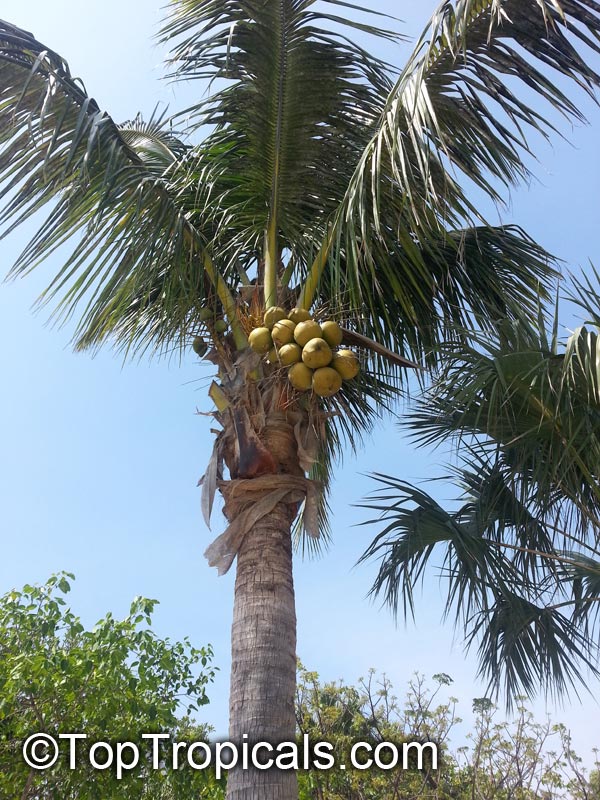
Coconut palm, Cocos nucifera

Fan palm - Licuala sp.

Areca palm - Areca (Dypsis) lutescens
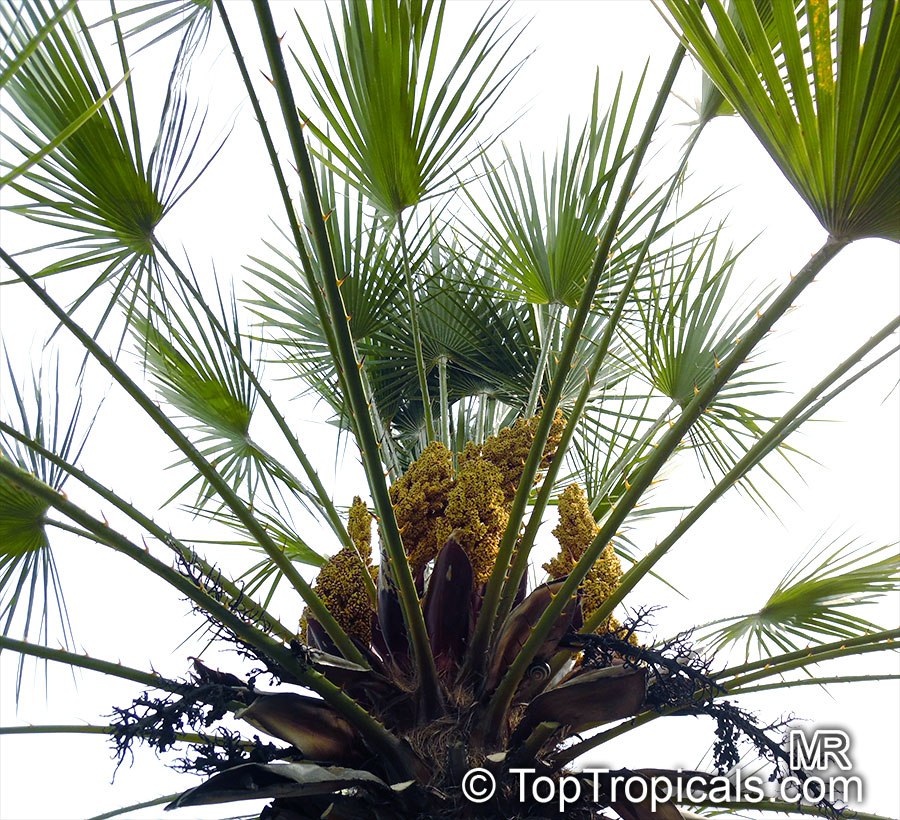
Windmill palm - Trachycarpus fortunei

Cabbage palm - Sabal palmetto
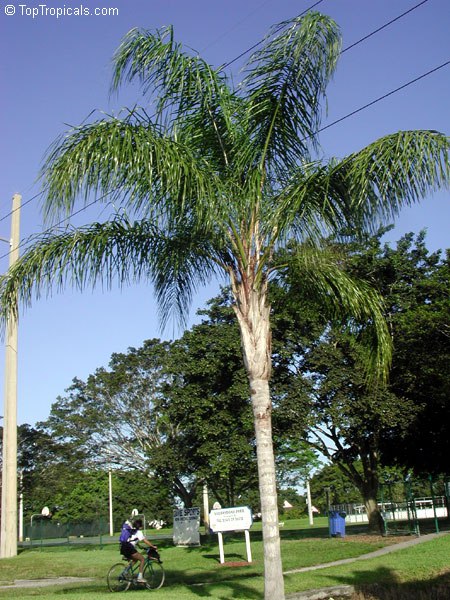
Queen Palm - Syagrus romanzoffiana

Majestic palm, Royal Palm - Ravenea rivularis

European fan palm - Chamaerops humilis

Date Palm - Phoenix canariensis
🌴 How cold hardy are palm trees and how to protect them in winter
🌴 Most palms are tropical plants and require a frost-free climate to grow outdoors. However, there are a few exceptions. Adjust care depending on your zone and palm species.
🌴 Some cold-hardy species can handle harsher conditions, with proper protection, making them great options for gardeners in zones that experience occasional freezes.
🌴 Mulch generously: Apply a thick layer of mulch around the base to insulate roots. Keep mulch a few inches away from the trunk to prevent rot.
🌴 Water before frost: Water deeply before a freeze to stabilize soil temperature and prevent dehydration.
🌴 Cover young palms: Wrap smaller or sensitive species in burlap, frost cloth, or blankets. Avoid plastic, as it can trap moisture and cause damage.
🌴 Protect the crown: For cold-sensitive palms, bundle fronds upwards and wrap the crown with cloth or burlap to shield the growing point.
🌴 Use heat sources: Place Christmas lights (non-LED) or a heat lamp near the tree, ensuring they’re safe and don't touch the foliage.
🌴 Avoid pruning: Keep fronds intact during winter—they provide natural insulation.
🌴 Species-specific care: Cold-hardy palms need less protection. Delicate types require more attention, including covering and relocating potted ones indoors.
📷 In the photos:
🌞 Cold sensitive palms:
Coconut palm: Cocos nucifera
Fan palm: Licuala sp.
Areca palm: Areca (Dypsis) lutescens
❄️ Cold hardy palms:
Windmill palm: Trachycarpus fortunei
Cabbage palm: Sabal palmetto
Queen Palm: Syagrus romanzoffiana
Majestic palm: Ravenea rivularis
European fan palm: Chamaerops humilis
Date Palm: Phoenix canariensis
🛒 Shop Palm Trees
#Trees #How_to
🔴 Join 👉 TopTropicals
📷 In the photos:
🌞 Cold sensitive palms:
Coconut palm: Cocos nucifera
Fan palm: Licuala sp.
Areca palm: Areca (Dypsis) lutescens
❄️ Cold hardy palms:
Windmill palm: Trachycarpus fortunei
Cabbage palm: Sabal palmetto
Queen Palm: Syagrus romanzoffiana
Majestic palm: Ravenea rivularis
European fan palm: Chamaerops humilis
Date Palm: Phoenix canariensis
🛒 Shop Palm Trees
#Trees #How_to
🔴 Join 👉 TopTropicals
Why getting bigger plants in bigger pots are a better choice than smaller ones
🏝 Why getting bigger plants in bigger pots are a better choice than smaller ones
Stronger Roots: Bigger pots give roots more room to spread, making them stronger and healthier.
Easier to Establish: These plants adjust more quickly when planted, making them easier to care for.
Faster Growth: Plants will grow faster once planted in your garden, as their larger root systems help them absorb nutrients and water more effectively.
Better Resilience: Larger plants can handle stress, like temperature changes or less watering, better than smaller ones.
🍀 Choosing a plant in 3-7 gallon pot means a healthier, faster-growing plant with less work needed, than for 1 gal plant.
#Trees #How_to
🔴 Join 👉 TopTropicals
Stronger Roots: Bigger pots give roots more room to spread, making them stronger and healthier.
Easier to Establish: These plants adjust more quickly when planted, making them easier to care for.
Faster Growth: Plants will grow faster once planted in your garden, as their larger root systems help them absorb nutrients and water more effectively.
Better Resilience: Larger plants can handle stress, like temperature changes or less watering, better than smaller ones.
🍀 Choosing a plant in 3-7 gallon pot means a healthier, faster-growing plant with less work needed, than for 1 gal plant.
#Trees #How_to
🔴 Join 👉 TopTropicals
How much water is too much?
💧 How much water is too much?
🌴 "Always over-water your plants: just improve their soil drainage!" - Murray Corman, horticulturist, rare tropical fruit tree expert.
Read full article.
👍 What makes an issue for you? Over water or forgetting to water? Share in comments⬇️
📚 Learn more about potting soil
🛒 Shop soil mixes
#How_to
🔴 Join 👉 TopTropicals
🌴 "Always over-water your plants: just improve their soil drainage!" - Murray Corman, horticulturist, rare tropical fruit tree expert.
🐸 One of the most common challenges in tropical plant care, including houseplants, is overwatering, particularly in container gardening. So, how much water is too much?
🐸 Surprisingly, water itself isn't harmful to plants, no matter how generous your watering is. The real issue is poor drainage, which leads to stagnation and bacterial buildup, ultimately causing root rot.
🐸 If you've traveled to places like Hawaii or explored tropical jungles, you might have noticed plants thriving between rocks with minimal soil, receiving a near-constant fine mist of rain. Conversely, swamps support very few trees - only bog or water plants adapted to wet conditions can survive there. The lesson? It's not the water, it's the growing medium!
🐸 The Solution: For potted plants, always use a high-quality potting mix with excellent drainage properties. This should include ample "soil conditioners" such as perlite, vermiculite, and pine bark. At our nursery, we use a professional soil mix called Abundance.
Read full article.
👍 What makes an issue for you? Over water or forgetting to water? Share in comments⬇️
📚 Learn more about potting soil
🛒 Shop soil mixes
#How_to
🔴 Join 👉 TopTropicals
10 key tips for successful overwintering of tropical plants indoors
10 key tips for successful overwintering of tropical plants indoors
1. Maximize Light: The more light, the better. There's no such thing as too much indoor light. If windows aren't enough, use LED grow lights, which stay cool and won't dry the air. Rotate plants every few days to prevent uneven leaf loss.
2. Reduce Watering: Less light and cooler temperatures mean plants need less water. Allow the soil to dry between waterings, and avoid overwatering - combination of cold + wet is especially harmful.
3. Maintain Moderate Temperatures: Most tropicals are happy with daytime temperatures around 75F and nights at 50-60F. In sunrooms or greenhouses, some can handle 45F if watering is kept to a minimum.
4. Boost Humidity: Avoid placing plants near heaters or vents that dry the air. Misting daily helps, or place pots on trays filled with water and pebbles to raise humidity around them.
5. Monitor for Pests: Check leaves weekly to catch insect problems early, as pests can cause serious damage or even kill the plant indoors.
6. Fertilize Smart: Use ONLY liquid, amino-acid-based fertilizers like Sunshine Boosters throughout winter; they won't burn roots since their dosage adjusts with reduced watering. Avoid dry, granulated, and EDTA-based fertilizers during winter and dormancy.
7. Use Micro-Nutrients: Along with macro-elements (fertilizers), supplement with micro-elements like Sunshine Superfood and bio-stimulants such as Sunshine Epi to build strong plants with robust immune systems, better able to withstand unfavorable conditions and resist diseases.
8. Hold Off on Pruning: Leaf drop and leggy growth are normal responses to winter. Wait until spring to prune, when new growth starts, to encourage branching and healthy foliage.
9. Don't Repot Yet: During dormancy, roots slow their growth. Repotting too soon risks root rot. Wait until spring when new growth appears to transplant into a larger container. Typically, roots grow in proportion to the above-ground parts.
10. Let Them Rest: Winter is a natural resting period. Avoid forcing growth - your plants will reward your patience with vibrant leaves and flowers when spring returns.
🛒 Shop Indoor plants
#How_to
🔴 Join 👉 TopTropicals
1. Maximize Light: The more light, the better. There's no such thing as too much indoor light. If windows aren't enough, use LED grow lights, which stay cool and won't dry the air. Rotate plants every few days to prevent uneven leaf loss.
2. Reduce Watering: Less light and cooler temperatures mean plants need less water. Allow the soil to dry between waterings, and avoid overwatering - combination of cold + wet is especially harmful.
3. Maintain Moderate Temperatures: Most tropicals are happy with daytime temperatures around 75F and nights at 50-60F. In sunrooms or greenhouses, some can handle 45F if watering is kept to a minimum.
4. Boost Humidity: Avoid placing plants near heaters or vents that dry the air. Misting daily helps, or place pots on trays filled with water and pebbles to raise humidity around them.
5. Monitor for Pests: Check leaves weekly to catch insect problems early, as pests can cause serious damage or even kill the plant indoors.
6. Fertilize Smart: Use ONLY liquid, amino-acid-based fertilizers like Sunshine Boosters throughout winter; they won't burn roots since their dosage adjusts with reduced watering. Avoid dry, granulated, and EDTA-based fertilizers during winter and dormancy.
7. Use Micro-Nutrients: Along with macro-elements (fertilizers), supplement with micro-elements like Sunshine Superfood and bio-stimulants such as Sunshine Epi to build strong plants with robust immune systems, better able to withstand unfavorable conditions and resist diseases.
8. Hold Off on Pruning: Leaf drop and leggy growth are normal responses to winter. Wait until spring to prune, when new growth starts, to encourage branching and healthy foliage.
9. Don't Repot Yet: During dormancy, roots slow their growth. Repotting too soon risks root rot. Wait until spring when new growth appears to transplant into a larger container. Typically, roots grow in proportion to the above-ground parts.
10. Let Them Rest: Winter is a natural resting period. Avoid forcing growth - your plants will reward your patience with vibrant leaves and flowers when spring returns.
🛒 Shop Indoor plants
#How_to
🔴 Join 👉 TopTropicals
